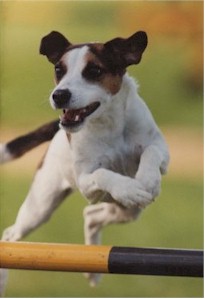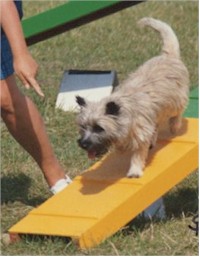Teaching contacts
 Kay
Westgate, the 'Silver Surfer' from Harlow, uses clicker training techniques to train her dogs
for filmwork and fun. Her JRT Ozzie (the Nat West dog) loves to work and does agility with
great enthusiasm. A bat out of hell best describes his performance. At the moment, however, his
touchpoints could be described as atrocious so Kay is using this method to correct this
problem. So far he is responding well, but then he is already clicker aware! Kay
Westgate, the 'Silver Surfer' from Harlow, uses clicker training techniques to train her dogs
for filmwork and fun. Her JRT Ozzie (the Nat West dog) loves to work and does agility with
great enthusiasm. A bat out of hell best describes his performance. At the moment, however, his
touchpoints could be described as atrocious so Kay is using this method to correct this
problem. So far he is responding well, but then he is already clicker aware!
For those of you whose dogs are not trained to the
clicker, the first step is to get them used to it. The method I use for touchpoints is a
follows:-
- First acquire a carpet square roughly 18" in
diameter.
- Place the square on a hard floor and with your
dog on the lead walk him over the square. When his front feet are actually on the
carpet, immediately Click and Treat.
- Continue until Fido realises that when his
feet hit the carpet he will get a Click and a Treat. They soon catch on! Now
add your cue word, such as mark, point or whatever word you want to use when he is
actually on the carpet.
- The next step is to try this exercise off
lead. Say the cue word and when Fido steps onto the carpet Click and Treat.
- Do not hurry any of these exercises, if he
does not understand when off the lead go back a step and do it on lead again until he
gets the idea! When your dog really understands this method you can transfer it to
training.
 What
to do What
to do
Start with the dogwalk first.
- Put your carpet on the bottom of the touchpoint, 2/3
on the equipment and 1/3 on the ground.
- With the dog on lead, walk him over the equipment
and when his feet are on the carpet in the position you want, say your cue word and Click
and Treat.
- Continue this until you feel confident that Fido
knows what he has to do.
- Now try off lead.
- At this stage he will probably be some way ahead of
you so when he is three quarters down the descending plank say your cue word. If your dog
fully understands this exercise, he will stand on the carpet and wait for you to Click and
Treat him.
- When you are getting consistent results cut the
piece of carpet in half and continue training. Gradually make the carpet piece smaller and
smaller and eventually dispense with it completely. At this stage still continue to Click
and Treat every time.
 Other
contact equipment Other
contact equipment
You can do the same with the A -frame.
For the seesaw, you will have to use
a smaller piece of carpet with some double sided tape to keep it in place on the end of the
equipment but the training is the same for all three pieces of equipment.
After a long period you can then
phase out the clicker and just use a reward for the correct behaviour. To do this, start
randomly Clicking and Treating as set out on my website.
I do not pretend that Clicker
Training is the answer for everyone, but it gives another method for agility folk to try if
they are experiencing problems. Where it differs from conventional training is that the dog has
to work it out for themselves instead of being physically shown - this is what Clicker Training
is all about!
To use Clicker Training to teach
jumping and weaving dogs are trained with the use of a touchstick. If anyone is interested I
would be happy to give further details later. However, I do not know as yet how to apply it to
tunnels!
For an explanation of this in
full, please visit my website on
http://www.k9clickers.com
where it is set out in easy steps.
 About
the author About
the author
Kay Westgate took early medical retirement
from her career as Civilian Personnel Officer for the City of London Police in l989. Having the
dogs certainly helped her back on the road to recovery!
She got the 'agility bug' at Trent Park DAC where she
started learning agility with Toby, a Cairn Terrier who was built more for stamina than speed.
Toby was two years old then. She then acquired Sam in l990. He was a ten months old rescue dog
from the local pound. Despite his bad start, he was such a gentle little lad and so keen to
learn anything so she took him to agility and we never looked back.
She competed at Crufts 1994 and 1995 when
they took part in all three Eukanuba Mini events plus the flyball which is probably a record
for a mini dog! She was at Crufts again in 1996 when she won the Hills Mini Agility Dog of the
Year with Sam. They qualified for four Dogs in Need Finals. In 1992, he started his film career
and, although dark dogs are not supposed to get much work, he certainly did. Nothing phased him
on set, and he is now a veteran of many parts in film and television. The highlight of his
career has been his role as Crabb in the Oscar winning Shakespeare in Love.
Ozzie, also a rescue dog, came to Kay as a
pup of eight weeks old in 1996. Enthusiastic is an understatement when describing him. He lives
to work! She started to train him about 1997 at Axstane Agility Club, but now trains at Nick
Barnes' club in Hertford. It was natural he followed Sam into show business! Now much in demand
for all sorts of parts which he performs brilliantly!
Kay started using the clicker method in 1999
when training her dogs for film work. It really works so well! She studied this system by using
the Internet and obtaining various publications in particular by Karen Pryor and Gary Wilkes,
and then began helping other people train their dogs using this method. She was so successful
that she starter her own pet obedience classes in Harlow in 2000.
The results speak for themselves! Once you
know this method it is common sense applying it to almost anything you wish in dog training.
Whilst I do not suggest it is the answer to everything is certainly produces a keen and willing
dog. I think that it has a future for agility for those willing to try. I am using this to
retrain Ozzie on his touchpoints and although FMD has limited the amount of training I have
been able to do so far this year have high hopes for better results in the ring this year!
Postscript...
I have just returned from my first show at Supadogs and had the
chance to try out the clicker training on the contacts. I have been concentrating on the
dogwalk first and to this end got a result. Ozzie got every single contact he did on the
dogwalk.
I have not started the same thing on the A-frame and he
did not get many contacts, only one or two. This strengthens my belief in using the clicker for
training touchpoints. I am now going to use the method for the A-frame and hope to get the same
positive results. Last of all will be the see-saw. He jumped off the middle quite a few times
but got a couple towards the end.
From Penny Garner-Carpenter...
It was interesting to read the article on clicker
training and its uses in agility. I'm a great one for 'horses for courses' and am therefore
appalled at the thought of teaching all agility with a clicker! When other training works
better. However there are bits of agility which work really well with a clicker. Whilst I
didn't train Jed the weaves using a clicker I did use it to train the contacts and to 'wait'.
The wait was impossible to train without it - he would
run off to jump as soon as he could get my hand off his collar. Yet within five minutes of
clicker training he would wait whilst I went the two jumps ahead! Amazingly quick and easy for
him to learn. Whilst he will need reminding of what a 'wait' is! He really got the hang of it
very quickly.
Contacts? We didn't train the 'traditional' clicker
training way of backchaining, but instead clicked and treated on the contacts, once he got the
idea I introduced the command to go to the contact and then his release command. I must say
it's an improvement on what I did before.
The other aspect of clicker training I used (without a
clicker) was that of getting the action before introducing a command - so he learnt how to
'jump' or 'tyre' or 'weaves' etc before he heard what they were called. This is an excellent
technique which means the dog quickly learns what to do then what the command to do it is! Dogs
who are unaware of what a command means can find commands confusing and take longer to
understand what is required of them.
I would certainly use a clicker and the action first
command second techniques in agility again. (02/04/01)
|